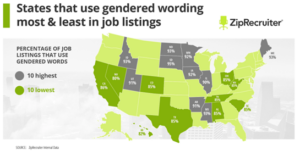To improve fairness in hiring practices, in 1973, job advertisements could no longer advertise specifically for men or women or use pronouns such as he or she. However, gender preferences can still be expressed in job postings simply based on language choices.
According to SHRM in 2020, questions to ask yourself about hiring bias include:
- Do I typically hire similar types of people or people who are like me?
- What do I mean when I say a candidate is not the right fit?
- What do I do if my candidate pool is not sufficiently diverse?
- What can I learn about my past hiring choices, both successful and unsuccessful?
GlassDoor outlines ways to ensure you are not bias when posting jobs, include:
- Be sure to use gender neutral titles in job descriptions
Male-oriented titles can inadvertently prevent women from clicking on your job in a list of search results. Avoid including words in your titles like “hacker,” “rockstar,” “superhero,” “guru,” and “ninja,” and use neutral, descriptive titles like “engineer,” “project manager,” or “developer.”
- Limit the number of requirements
Identify which requirements are “nice to have” versus “must have,” and eliminate the “nice-to-haves.” Research shows that women are unlikely to apply for a position unless they meet 100 percent of the requirements, while men will apply if they meet 60 percent of the requirements.
- Express your commitment to equality and diversity
Candidates want to know they’ll be welcome in your culture before they make the effort to apply. A simple statement toward the end of your job description lets candidates know that you intend to make the workplace a friendly one.
- Go blind when doing a resume review
Consider reviewing resumes without the access to the name and address of the candidate. Ensuring you are considering the education and qualifications of the candidate and not being swayed by any demographic information. Names can lead to bias and inaccurate assumptions of the candidate – names may create false theories about the gender, ethnicity and socioeconomic status of the candidate.
Zip Recruiter has mapped the use of gender language in job postings across the U.S.:

Below are some examples of gendered words in position postings:

Attracting and retaining a diverse and committed employee group continues to be a challenge in the current economic environment. Spending the time to evaluate your processes and practices to make sure you are drawing in the largest candidate pool possible pays off for everyone!

